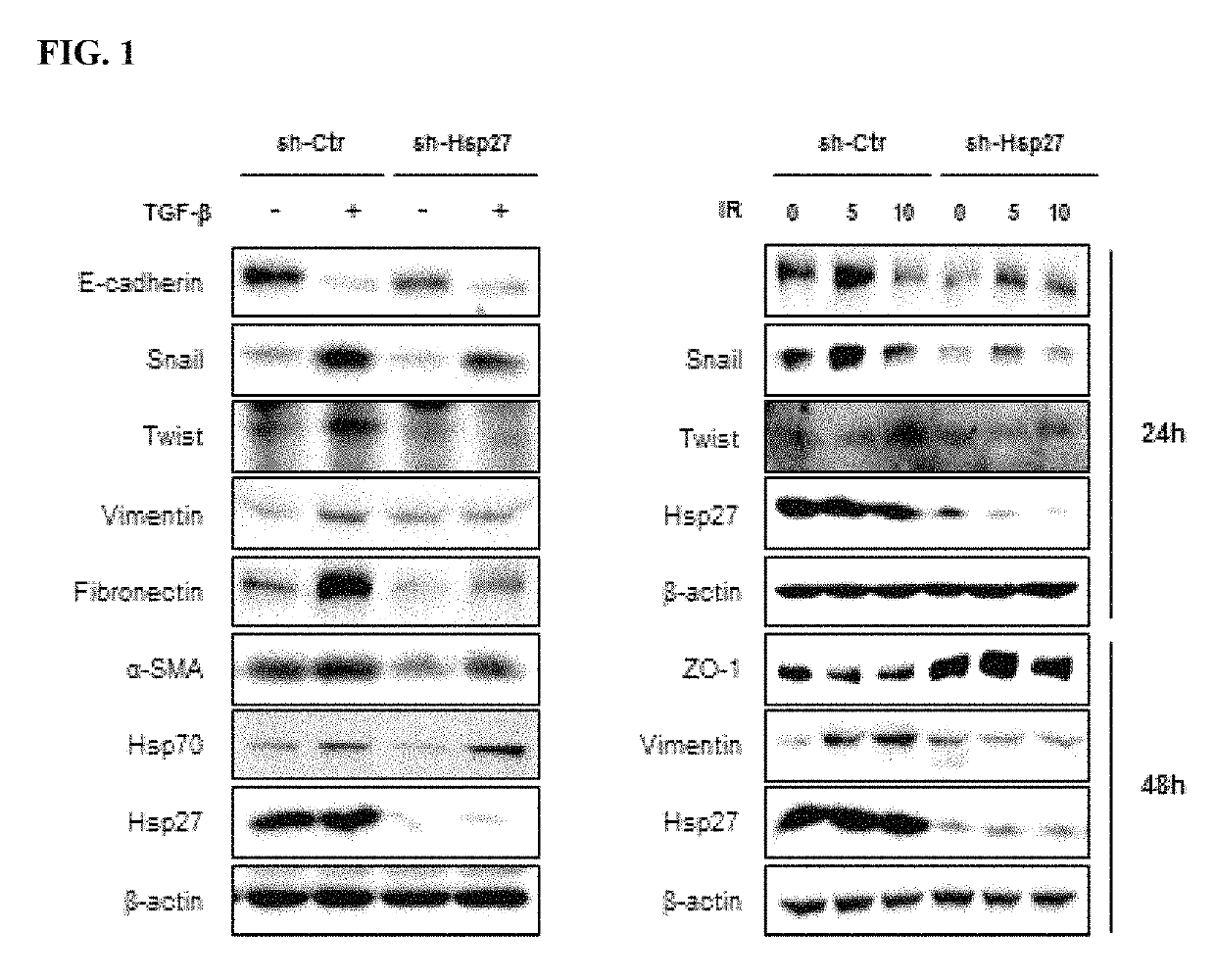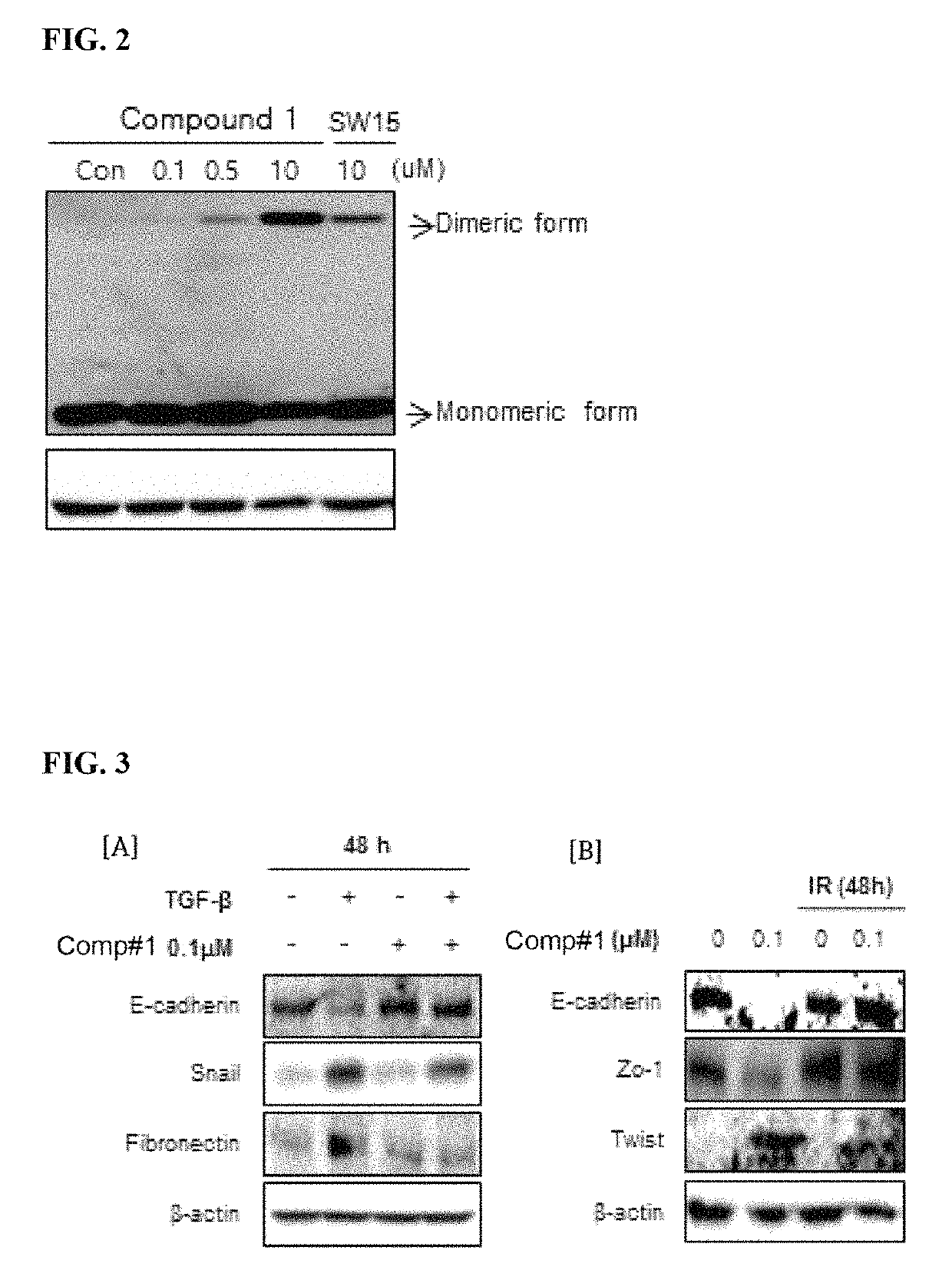Methods for treating pulmonary fibrosis using chromenone derivatives
a technology of chromenone and fibrosis, which is applied in the field of treating pulmonary fibrosis, can solve the problems of reducing the lung capacity of patients, no proper medicine, and all lung cancer patients who receive radiation treatment suffer mild or severe side effects on their lung organs, and achieve the effect of reducing the cell protection function
- Summary
- Abstract
- Description
- Claims
- Application Information
AI Technical Summary
Benefits of technology
Problems solved by technology
Method used
Image
Examples
example 1
of 5-hydroxy-2-methyl-7-(thiirane-2-ylmethoxy)-4H-chromene-4-one (Compound 1) and 2-methyl-5,7-bis(thiirane-2-ylmethoxy)-4H-chromene-4-one (Compound 2)
[0039]Epithiochlorohydrin (1.13 g, 10.40 mmol) was added to a reaction mixture of 5,7-dihydroxy-2-methyl-4H-chromene-4-one (0.50 g, 2.60 mmol) and K2CO3 (0.72 g, 5.20 mmol) in a DMF / acetone (20 mL / 10 mL) and then the reaction mixture was stirred at 90° C. for 21 h. After cooling the reaction mixture to room temperature, water was added and the reaction mixture was extracted with ethyl acetate. Organic layer was collected and washed with water and brine, which was dried over anhydrous MgSO4. Solvent was removed under reduced pressure and the residue was purified on a silica gel column chromatography (eluent: CH2Cl2→ethyl acetate:n-hexane=1:1) to obtain a compound 1 (ivory-colored solid, 0.32 g, 46.8%) and a compound 2 (orange-colored solid, 0.08 g, 8.7%).
[0040]Compound 1: Rf 0.36 (ethyl acetate:n-hexane=1:3); mp: 152-153° C.; HPLC: RT ...
example 2
of 5-hydroxy-7-(oxirane-2-ylmethoxy)-2-phenyl-4H-chromene-4-one (Compound 3) and 5,7-bis(oxirane-2-ylmethoxy)-2-phenyl-4H-chromene-4-one (Compound 4)
[0042]Epichlorohydrin (1.82 g, 19.65 mmol) was added to a reaction mixture of 5,7-dihydroxyflavone (1.00 g, 3.93 mmol) and K2CO3 (1.09 g, 7.86 mmol) in a DMF / acetone (12 mL / 4 mL) and then the reaction mixture was stirred at 90° C. for 20 h. After cooling the reaction mixture to room temperature, water was added and the reaction mixture was extracted with ethyl acetate. Organic layer was collected and washed with water and brine, which was dried over anhydrous MgSO4. Solvent was removed under reduced pressure and the residue was purified on a silica gel column chromatography (eluent:MeOH:CHCl3=3:97→4:96) to obtain a compound 3 (ivory-colored solid, 0.07 g, 5.7%) and a compound 4 (ivory-colored solid, 0.30 g, 20.8%).
[0043]Compound 3: Rf 0.24 (ethyl acetate:n-hexane=1:3); HPLC: RT 5.67 min (purity: 100%); 1H-NMR (CDCl3, 400 MHz) δ2.79 (dd,...
example 3
of 5-hydroxy-2-phenyl-7-(thiirane-2-ylmethoxy)-4H-chromene-4-one (Compound 5) and 2-phenyl-5,7-bis(thiirane-2-ylmethoxy)-4H-chromene-4-one (Compound 6)
[0045]Epichlorohydrin (0.64 g, 5.91 mmol) was added to a reaction mixture of 5,7-dihydroxyflavone (0.50 g, 1.97 mmol) and Cs2CO3 (1.28 g, 3.93 mmol) in a DMF / acetone (5 mL / 15 mL) r and then the reaction mixture was stirred at 80° C. for 20 h. After cooling the reaction mixture to room temperature, water was added and the reaction mixture was extracted with ethyl acetate. Organic layer was collected and washed with water and brine, which was dried over anhydrous MgSO4. Solvent was removed under reduced pressure and the residue was purified on a silica gel column chromatography (eluent: CH2Cl2→ethyl acetate:n-hexane=2:1) to obtain a compound 5 (yellow-colored solid, 0.05 g, 8.0%) and a compound 6 (yellow-colored solid, 0.08 g, 8.9%).
[0046]Compound 5: Rf 0.47 (ethyl acetate:n-hexane=1:3); HPLC: RT 8.30 min (purity: 98.56%); 1H-NMR (CDCl3...
PUM
| Property | Measurement | Unit |
|---|---|---|
| temperature | aaaaa | aaaaa |
| temperature | aaaaa | aaaaa |
| pH | aaaaa | aaaaa |
Abstract
Description
Claims
Application Information
 Login to View More
Login to View More - R&D
- Intellectual Property
- Life Sciences
- Materials
- Tech Scout
- Unparalleled Data Quality
- Higher Quality Content
- 60% Fewer Hallucinations
Browse by: Latest US Patents, China's latest patents, Technical Efficacy Thesaurus, Application Domain, Technology Topic, Popular Technical Reports.
© 2025 PatSnap. All rights reserved.Legal|Privacy policy|Modern Slavery Act Transparency Statement|Sitemap|About US| Contact US: help@patsnap.com



